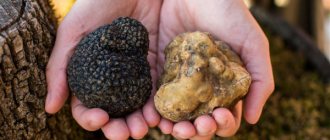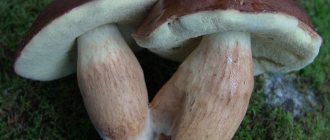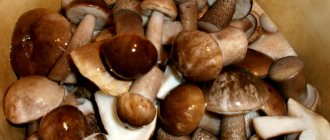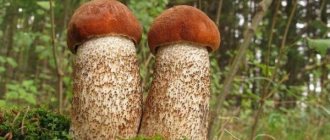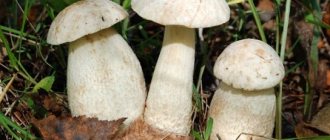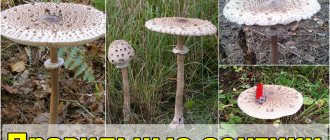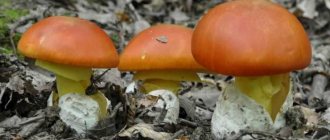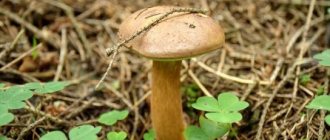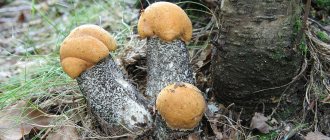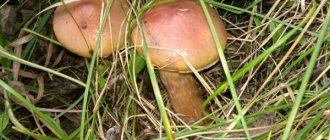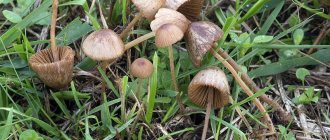Hello dear reader!
Continuing the “mushroom” theme of my blog, today I will tell you about another wonderful inhabitant of our forests, who brings mushroom pickers a lot of joy. This is a boletus mushroom, one of the highest quality and, importantly, one of the most common mushrooms in our forest.
Actually, the correct scientific name of the mushroom is red aspen, in Latin Leccinum aurantiacum. In addition, the mushroom has many local names. The most common of them - redhead and red mushroom - are associated with the most noticeable property of the boletus, the color of the cap.
What does a boletus look like?
Despite the diversity of species, boletuses (or red mushrooms, red mushrooms, etc.) are distinguished by their massiveness, elastic stem, bright cap and dense consistency of the fruiting body. The diameter of the cap varies between 5-20 cm. Sometimes you come across real giants - about 30 cm.
Young boletuses
If the mushroom is young, then its cap has a hemispherical shape. It wraps the leg tightly. With age, it becomes convex, pillow-shaped, and then completely straightens.
The skin is usually impossible to remove. It is dry to the touch, sometimes velvety. The leg is club-shaped (thick at the bottom, thin at the top). It grows up to 22 cm. The leg itself is light, but covered with numerous dark scales.
Tubular layer of boletus
The spore-bearing layer of boletus is tubular. Its thickness is about 1-3 cm. The color is usually white, yellow, gray or brownish. The spore powder is brown or olive-brown in color.
The cap flesh is dense, elastic and fleshy. The stalk is characterized by a longitudinal arrangement of fibers. The pulp is white, but if damaged it quickly turns blue, and, after some time, turns black.
Notes
- All about mushrooms / ed.-comp. N. G. Lebedeva. - Kharkov: "Relic", 1997. - P. 22. - ISBN 9984-9011-0-7.
Boletus
Boletus is a variety of well-known mushrooms. They received their unusual name not only because of the place of germination, but also from the word “autumn”. The color of the cap of this mushroom is very similar to the colors of autumn foliage. When it falls, the boletus merges into one color with the fallen leaves. There are many varieties of these mushrooms. All of them have a unique taste and are very useful for humans.
Yellow-brown (red-brown) boletus
Yellow-brown boletus (Leccinum versipelle)
The largest among all representatives of these mushrooms. The cap can reach 30 cm in diameter. Often inexperienced mushroom pickers are afraid and pass by such a boletus, which is completely in vain; it is quite easy to distinguish it from a false one. The mushroom must be broken, in the damaged area it should first acquire a pinkish tint, and then purple.
Red boletus
Red boletus
This mushroom is much easier to recognize. Its cap has a deep red color and is most noticeable among the foliage, even from afar. The pulp is fleshy and very dense. The legs are white with small scales. Mushroom pickers should not be afraid of unusual changes when collecting this species. When the mushroom is cut, the damaged area acquires a blue tint and then turns black.
Pine boletus
Pine boletus (Leccinum vulpinum)
The diameter of the cap of this type of mushroom can reach 15 cm. The color is brown-red, and over time it acquires a crimson hue, which does not even look natural. Externally it has a velvety appearance. The peculiarity of the mushroom is to change the color of the pulp. This does not depend on damage; this process occurs on its own during growth and maturation.
White boletus
White boletus
The name of the mushroom speaks for itself about its color. Both their cap and stem are pure white. Although this applies only to young representatives of mushrooms. Large mushrooms are gray in color. In a broken place they acquire a blue tint, which soon turns black.
Painted-legged boletus
Colored-legged boletus
This mushroom is slightly different from other boletuses. It is characterized by a pink cap, which can be either flat or convex. Its leg is covered with pinkish scales. The color at the base is rich yellow, gradually turning into white and pink towards the top. This variety is especially loved by insects and various kinds of worms.
Redhead oak boletus
Oak boletus (Leccinum vulpinum)
Young representatives of this species are very unusual. The hat looks like a thimble placed on a finger. Its edges fit tightly to the stem, giving the mushroom a spherical shape. Over time, the diameter of the cap can increase to 30 centimeters. Mushroom pickers are very fond of the Redhead mushroom, it is tasty and looks aesthetically pleasing. In older mushrooms, the cap takes on a cushion shape. The color of the cap becomes red mixed with orange tones. Mature mushrooms are characterized by a velvety texture. The leg is white with reddish scales and shaped like a cylinder. It can reach a height of 20 cm and a thickness of up to 5 cm. The scales on the legs quickly darken, which indicates the growth and maturity of the mushroom. The lifespan of this species is very short. Only 11 days. The older you get, the more decrepit the mushroom pulp becomes.
Spruce boletus
Spruce boletus (Leccinum peccinum)
The color of the cap is brown-red. Can reach up to 10 cm in diameter. The skin is not smooth, it hangs slightly from the base, forming a slight overlap over the stem. The cap is covered with small scales, slightly lighter than the main tone. The length of the leg reaches 13 cm, and the thickness reaches three. The mushroom got its name due to the places where it germinates. They can be found in spruce, coniferous forests, and oak forests. These mushrooms grow in large groups.
Black-scaled boletus
Black-scaled boletus
The habitat of this species is solitary aspen trees. The color of the cap has a reddish-brick tint. Young individuals have a velvety, matte cap. As she ages, she becomes “naked.” The shape at first resembles a ball, and as it grows it becomes more like a pillow. The stems of young mushrooms are white and gradually turn gray with an olive tint. The height of the leg can reach 18 cm. It is covered with reddish scales. When cut, the mushroom immediately acquires a purple color, and after a while it changes to black.
There are other types of boletuses, described earlier - these are the main ones.
A variety of these mushrooms can be found in almost any forest. They grow in the Far East, Siberia, the Caucasus and even in Europe. As with any mushrooms, the wetter the weather, the more there are. The collection begins from the beginning of summer until the end of September. It happens that they can be found until frost. Some types of boletus prefer special growing conditions. White boletus - prefers deciduous or mixed forests with high humidity. Mushroom pickers should remember that it is listed in the Red Book.
Yellow-brown representatives can be found in pine and birch areas. Their favorite habitat is under a fern leaf.
Red ones - they choose young single aspen trees, although they are often found by mushroom pickers in pine, mixed and deciduous forests. This variety of boletus should be looked for in clearings, near roads and in the grass.
Pine - they love dampness, they can be collected in coniferous forests.
For boletuses, the most important thing is that direct sunlight does not penetrate into their habitats and that a light, cool breeze blows.
Why is the boletus called that?
The Latin name for the genus of mushrooms is Leccinum (they also include boletus mushrooms). Boletus got its name by analogy with boletus - due to the ability of the fungus to form stable mycorrhiza with aspen. However, its different species also grow near other trees.
Mature boletus
Other names for the mushroom:
- aspen;
- red mushroom;
- redhead;
- obabok;
- chelysh.
The remaining names were assigned to the boletus for its characteristic appearance - a red cap and its shades.
Edible mushroom very similar to boletus
The genus Leccinum includes a considerable number of mushrooms, among which there are not only boletuses, but also boletus mushrooms. Exactly one of the types of boletus, and specifically the harsh boletus
(Leccinum duriusculum) is very similar to boletus in many ways. This mushroom forms mycorrhiza with aspens and poplars, has a dense pulp structure that darkens when cut, there are often bluish spots at the base of its stem, and in general its appearance resembles a typical aspen boletus.
Have you noticed how much these mushrooms have in common? Well, now it’s worth talking about the differences. The first thing that catches your eye is the cap; the cap of the boletus boletus is grey-brown or brown; similar colors can only be found in the spruce or oak boletus. When cut, the boletus pulp does not darken immediately; initially it acquires a reddish tint and only later becomes almost black.
The tough boletus is rarely wormy. This is associated primarily with its dense pulp. It bears the greatest resemblance to boletuses at a young age, when its cap has not yet opened. In terms of nutritional value, this boletus is not inferior to boletus.
Well, my story about boletuses can be considered complete. I tried to reflect in the article the most complete information about these wonderful mushrooms, using personal knowledge, books and the Internet. I hope you found it interesting!
Why does the boletus darken when cut?
All boletuses have white flesh, but if the fruiting body is damaged, it turns blue, purple, or black. Only isolated spots may appear on the pulp, or the entire inner surface may darken.
Boletus cut
This phenomenon is not dangerous, although it spoils the appetizing appearance of the little guy. The fact is that it contains a special substance - variegated acid. When the integrity of the pulp is compromised, the process of interaction of this acid with air begins. Oxidation occurs to form quinomethide anion with a blue hue.
The darkening of the mushroom pulp is similar to the oxidation of some vegetables and fruits, which also change color. In its pure form, the pigment oxidizes more slowly, therefore, red mushrooms contain substances that accelerate this process.
How to cook boletus
Boletus is a noble mushroom, but it still requires heat treatment . Processing mushrooms should not be delayed; they spoil quickly.
Boletus boletuses for 20 minutes. You can make mushroom soup from Boletuses.
Fry the boletuses for 30-40 minutes.
Drying boletuses
Clear the boletuses from twigs, grass and soil.
Boletus mushrooms must not be washed before drying ! Mushrooms take on water very quickly, and washed mushrooms cannot be dried.
Small boletuses are dried whole, large ones are cut, but not finely. It is best to dry on a thread or in the oven. The oven temperature should be set at 50-60 degrees - this is the minimum available mode and the door is slightly open. Some oven models will require you to open the door completely due to the inability to lower the temperature. Dry the mushrooms on a baking sheet lined with parchment. Place on the top shelf.
Where and when do boletuses grow?
Boletus is considered one of the most common mushrooms. It grows in the temperate zone of Eurasia and North America. Each species has a tree species that is most suitable for it.
Therefore, boletuses grow near oaks, birches, willows, poplars, spruces, and not just under aspens. Most often they grow in groups, but sometimes there are also “loners”. Optimal conditions for them are conditions with high humidity - forests and bushes, where there is a lot of shade.
Interesting: Boletus - description, what it looks like, where it grows, when to collect, varieties, photos and videos
Many boletuses in a pine forest
The growth time is also determined by the species. Boletuses are divided into 3 categories depending on when they grow:
- spikelets;
- reapers;
- deciduous plants.
The first mushrooms, spikelets, appear at the end of June, but usually there are not many of them. These include species such as white and yellow-brown boletus. The peak of growth occurs in July-August - you can count on an abundance of stubble mushrooms. These are oak boletus, black-scaled and red boletus.
Boletuses on coniferous litter
By the way, species that grow under deciduous trees love warmth, so it is best to collect them in summer and early autumn. The same species that form symbioses with conifers can bear fruit before the first low temperatures in October.
This is explained by the fact that coniferous litter protects the mycelium from low temperatures for a long time. Deciduous species include pine and spruce.
How to preserve the color of mushrooms when cooking?
To preserve the beautiful light shade of young mushrooms, add a little citric acid to the water when cooking mushrooms. Experienced housewives manage to maintain a beautiful color even during prolonged cooking and even during stewing. If you don't have lemon on hand, add half a spoon of vinegar and boil the mushrooms well.
Interesting materials:
How many times was Nagiyev married? How many times should a teenager bathe? How many times do you need to do sugaring for your hair to stop growing? How many times should a dog be vaccinated against distemper? How many times has Real Madrid won the Champions League? How many times a day should you read Sytin's moods? How many times a day should you feed your guppy fish? How many times a week should you bathe your cockatiel? How many times a week do geraniums be watered? How many times a week should you train pull-ups?
How long does the boletus grow? When to collect?
Boletuses occupy a leading place in terms of growth rate. For example, a mushroom can grow a couple of centimeters in a day. Weather conditions affect the growth rate of boletuses.
Stages of boletus growth - from the youngest to the most mature mushroom
After a heavy rain within a day, they become quite impressive in size, since they quickly absorb moisture from the soil and all useful substances. By the way, the absorption of harmful substances by mushrooms also occurs, so it is very important to collect them only in environmentally friendly areas.
Interesting fact : the lifespan of mycelium (mycelium) reaches 80 years. In order for boletuses to grow in the same place repeatedly, they should be collected carefully.
If it rains frequently, then the collection of redheads can continue throughout the summer and autumn until it gets colder. After the rain, just wait a day - the mushrooms will already have reached the desired size. If cold weather persists, the red mushroom takes 3-4 days to reach its optimal size.
Types of boletuses
Most types of boletus are edible and pleasant to the taste, but there is also a false boletus. But to make mushroom hunting more interesting, study the differences and individual properties of their varieties.
Red boletus
This edible mushroom is distinguished by the fact that it does not choose a specific type of tree as a mycorrhizal partner, but is “friends” with a variety of deciduous giants: oak, beech, poplar, aspen, birch, and willow. Red boletus can be described as follows:
- The diameter of the cap ranges from 4 to 15 cm, in some cases reaching 30 cm.
- The height of the leg can be up to 15 cm, its thickness from 1.5 to 5 cm.
- The color of the cap can be bright red, red-brown, red. The skin fits tightly to the pulp, smooth or slightly velvety to the touch.
- The outer layer of the stem is covered with grey-white scales, which become brown as the mushroom matures.
If you cut a red boletus, at this point the color will change first to blue, then black. A group or single mushroom can be found in deciduous or mixed forests. He especially loves young aspen growth, various ditches and forest paths. The red boletus grows throughout the Eurasian territory; in the tundra it chooses places under dwarf birch trees. In our vast homeland, it can be seen everywhere - from the European part to the Far East, including the Caucasus. You can collect red boletus during the harvest season: from June to October.
Boletus yellow-brown
It is an edible mushroom and is in symbiosis with birch trees . Lowland forest belts with a predominance of aspen and birch are chosen as a place of growth; they can be found in spruce-birch forests and pine forests. They grow in areas with temperate climates. Description:
- The diameter of the cap is from 5 to 15 cm, sometimes 25 cm.
- The leg is tall, reaches 8-22 cm, its thickness is approximately 2-4 cm.
- The cap is sandy-orange or yellowish-brown.
- In young mushrooms, the dry skin of the cap often hangs over the edge.
- The leg has a white or grayish tint, covered with granular brown scales, turning black as it grows.
Usually grows singly. If the leg is cut off, at this point it will turn pink , then blue, after which it will acquire a purple tint, sometimes green. This type of mushroom is collected all summer. But sometimes they are seen at the end of November.
Redhead pine
Belongs to edible mushrooms. It has a red-brown cap with a dark crimson tint , which distinguishes it from its fellows. Grows near pine and bearberry. Description:
- The diameter of the dry velvety cap reaches 15 cm.
- The length of the leg grows up to 15 cm, its thickness reaches 5 cm. The leg of the redhead has small, brownish scales.
At the cut site, the flesh turns blue , then turns black. This species is less common than the red boletus. Grows in damp coniferous forests in temperate latitudes of Europe.
Redhead spruce
This is an edible mushroom. You can describe it like this.
- The hat is a rich brown-chestnut color, hangs slightly from the edge, its diameter is from 3 to 10 cm.
- The cylinder-shaped leg has light brown scales on the surface and widens slightly towards the base. The length reaches 8-14 cm, thickness - 1.5-3 cm.
The pulp of the redhead is dense, white, and becomes dark when cut. Spruce boletuses are grouped in coniferous forests, usually under spruce trees, and are found in oak forests and mixed forests. The harvest season begins in July and lasts until October.
Black-scaled boletus
This edible mushroom has a red-orange , dark reddish or brick-red cap.
In a young mushroom it is semicircular, dry, slightly velvety. Over time, it acquires a cushion shape, becomes smooth, and reaches from 4 to 12 cm in diameter. There are reddish scales on a stalk 13-18 cm high. The pulp is firm, white, and when cut becomes purple or gray-black. So, we learned that the boletus mushroom is edible . It owes its name to aspen, since it is closely related to its roots, and the color of the cap resembles an autumn leaf. And each type has its own characteristics and differences from others.
Sources:
https://fermer.blog/bok/griby/sedobnye-griby/podosinovik/13577-podosinovik-i-podberezovik-otlichie.html https://voprosy-pochemu.ru/pochemu-podberezovik-tak-nazyvaetsya/ https:/ /domsad.guru/griby/opisanie-kak-vyglyadit-podosinovik-gde-rastet-pochemu-tak-nazyvaetsya.html
Red
A variety of boletus that can form mycorrhiza with different species (deciduous). The sizes of mushrooms are different - the caps are from 4 to 15 cm, sometimes more. The legs are tall (up to 15 cm), massive (1.5-5 cm).
Red boletus
Possible red, red, red-brown color of the cap. The skin fits tightly to the cap, does not need to be cleaned, and has a velvety feel to the touch. The light leg is covered with darker scales. The flesh is white, turning blue at the break. The species is widespread, grows in warm weather - June-October.
text-reasoning about the names of the mushrooms boletus boletus.
The boletus mushroom grows in deciduous forests, mainly in birch forests.
Mushrooms are found in parks and young growths of birch trees near forests; they love the edges of clearings, overgrown old paths in light mixed forests and along the edges of ravines. The boletus appears at the end of May at the same time as boletus and white boletus, or a little earlier. The boletus loves warmth and grows where the sun warms up the soil with mycelium well. The boletus has four varieties: • Common • Black • Swamp or white • Pinkish The most valuable is the common boletus, it is found most often and has the best taste among its relatives. The common boletus has a cap up to 15 cm in diameter, light brown (for young ones) and dark brown (for mature ones). The pulp is white, dense, and does not change color. Found in birch forests, on the edges of clearings, and in young birch trees. The common boletus has all the advantages of an edible mushroom: it has a pleasant smell and excellent taste. Very good for frying, suitable for drying and pickling. Do you know why aspen boletus is called that?
In the forest, a red cap of a mushroom peeks out from under old fallen aspen leaves. This is an aspen boletus. And a little further away, under that birch tree, a brown boletus cap sticks out. I carefully tear apart the fallen leaves. Yes, there is a whole family of boletus mushrooms: two, three, four... One is smaller than the other. In order not to spoil the cap of the mushroom, I take hold of the bottom of the stem. The root of the mushroom sits tightly in the ground. I quietly remove the top layer of soil and see: thin white mycelium threads go from the root into the ground in different directions. These threads are so intertwined with each other that it is difficult to keep track of where they go next.
It turns out that my entire family of boletus mushrooms is connected to each other underground by these white threads, and all these baby boletus mushrooms are siblings, growing from the same ball of threads, from the same mycelium. The threads of the mycelium, making their way in the ground between the roots of flowers and trees, absorb water and food along the way. Their food is fallen old leaves and last year's rotting grass. Threads water and feed the leg and cap of the mushroom. But what is it?
Individual threads of mycelium come very close to the living roots of birch. They entwine the roots from all sides, they penetrate into the very root. The food they get from the old rotting remains of plants is not enough for them, and they extract sap from living trees by sucking on their roots.
But the tree itself does not lose from this proximity: the threads of the fungus serve as additional roots for it and feed it in turn. The threads of the boletus are “friends” most often with the roots of the birch, the boletus is “friends” with the aspen, the camelina is with the Christmas tree, and so on; That is why each mushroom is found mostly around one specific tree.
There were no boletus in Sweden. And when larch was transplanted there, new mushrooms for Sweden appeared in these new forests - larch boletus.
I recommend you a new interesting video that can be very useful in your hobbies!
Paintedfoot
It stands out noticeably from others in appearance. It has a large convex or almost flat cap of a pink-brown hue. The leg is creamy pink, covered with red or pink scales.
Interesting: Honey mushrooms
